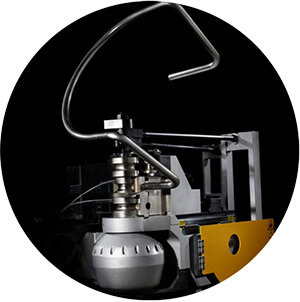The Ultimate Guide to Bending Metal Handrail
Metal handrail is an important part of commercial projects, they can provide security and aesthetics to staircases, balconies, and walkways. These handrails are usually not standard but custom-made in order to suit specific designs to ensure they can meet the architectural vision and safety requirements of the space.
In most cases, custom bending of metal handrails is required to achieve the precise angles, curves, or spirals that fit the structure’s unique design. Off-the-shelf handrails often cannot fit complex or non-standard layouts, so bent metal handrails are the best solution for a tailor-made solution.
Whether you are the manufacturer who wants to bend the metal handrails or the architect who wants to see the design of your metal handrails, it can be achieved. In this blog, we will get the answer you want to know. If you want to customize the tube bending machine for your metal handrail, TubeBenderN is your smart choice!

Understanding Metal Handrail Materials
When bending the handrail, choosing the metal tube material is important since each material has its own unique properties, and this will affect the bending process. Below are the main metal tube materials that are used for bending handrails.
Stainless Steel
Stainless steel tube is one of the most popular choices for handrails due to its durability, corrosion resistance, and sleek appearance.
Pros:
- High strength, durable, suitable for both indoor and outdoor use.
- Resistant to rust and corrosion, suitable for areas with high traffic volume or in bad weather conditions.
- Modern and sophisticated appearance.
Cons:
- High strength, so it is hard to bend, compared with the softer materials.
- Advanced tube bending technology is required to avoid breakage or other defects during the bending process.
We suggest using mandrel bending or heat-assisted techniques to bend the stainless steel tube since this material is very hard. Using the technique we suggest can help you get a better bending result.
Aluminum
Aluminum is lightweight and highly malleable; this feature makes it an excellent choice for handrails that require intricate or custom designs.
Pros:
- Easy to bend, even with simple tools.
- Lightweight, so for the project need to consider the weight of the material, this is a good choice. Aluminum tube is also suitable for indoor and outdoor use.
Cons:
- The strength is not as high as stainless steel. Pay attention to the usage scenario, reinforcement may be required.
- The surface is easily scratched or dented.
Brass
Brass handrails are mostly used for decoration, generally providing a classic, vintage look for some high-end projects.
Pros:
- Beautiful in appearance, it has a unique golden hue that adds a touch of vintage elegance.
- Malleable and relatively easy to bend into complex shapes.
- Corrosion resistant, suitable for indoor use.
Cons:
- The material price is higher than that of stainless steel and aluminum.
- It can tarnish over time, requiring maintenance to keep its aesthetic appeal.

Key Bending Techniques for Metal Handrails
Depending on the type of bending materials, the complexity of the design, and specific project requirements, you will need different bending techniques. Here are the common techniques for bending metal handrails:
Roll Bending
Roll bending is a technique that is used to bend large radius bends by passing the metal tubes through a series of rollers.
Advantages:
- Suitable for bending large radius bends without deformation.
- Minimal material stress, preserving the strength and integrity of the metal.
Limitations:
- Not suitable for sharp or tight bends.
Applications:
Commercial staircases, curved balconies, and ramps where large curves are needed.
Mandrel Bending
Mandrel bending uses a mandrel, which is a steel rod or ball, to insert into the tube during bending to ensure the tube does not deform.
Advantages:
- Ensure the metal bends are clean, tight, and without deformation.
- Suitable for intricate handrail designs and tighter angles.
Limitations:
- If the shape is complex, the tube bending process will take more time.
Heat-Assisted Bending
Heat-assisted bending, also known as hot bending, is the method that requires heating the metal before bending.
Advantages:
- Reduces the risk of cracking or breaking in tough metals.
- It can achieve the tight bends that cold bending can not do.
Limitations:
- More complex, need skilled operators to manage the temperature and bending process.
- Post-processing is required after bending to restore the strength and finish of the metal.
Application:
Custom architectural handrails, intricate designs, or bending hard metals like stainless steel that require heat to prevent brittleness.

Step-by-Step Guide to Bending Metal Handrails
Bending handrails of metal tube need your careful planning and execution to ensure the final product meets both aesthetic and structural needs. Here is a step-by-step guide for you to achieve the final bends.
Measure and Mark the Handrail
- Measure the section of the handrail that you need to bend and consider the overall length, bending radius, and bending angles.
- Mark the exact location where you need to bend. For the complex bending, you can make a drawing to show the bending design.
Tips: Before further steps, you’d better double-check all the measurement data; mistakes will lead to incorrect bending.
Choose the Right Bending Technique
According to the bending type and bending material, choose the proper bending technique.
- Roll bending for large bending radius.
- Mandrel bending for tight and complex bending.
- Heat-Assisted Bending for tough metals like stainless steel that are prone to cracking during cold bending.
Tips: Choose the bending technique that can match your metal tube’s strength and flexibility.
Secure the Handrail in the Bender
- Fix the handrail tube securely in the bending machine, and make sure the tube is properly aligned with the machine’s die to avoid twisting or uneven bends.
- Set the corresponding bending parameters.
Tips: For tight bends, ensure the mandrel is positioned properly to avoid bending defects.
Perform the Bend
In the beginning, the bending process needs to be slow and steady. Pay attention to monitoring the pipe bending process and stop the machine for inspection if necessary.
Check for Accuracy
- After the first bend, you need to measure the handrail again to ensure the bend matches the intended design and specifications.
- For a project that needs to assemble with other components, you can use the first bend sample to test. If necessary, adjust the bend parameters to match the perfect bending radius and angles.
Finish and Inspect
- If you use the heat-assisted bending technique, please wait until the handrail has cooled down before handling it.
- Check for any signs of deformation, kinks, or cracks. You can sand down or polish any rough edges or marks left by the bending process.
Are you looking for a tube bending machine for bending handrails? If yes, TubeBenderN is your best partner to get everything done in producing your metal handrail. Contact us to get a solution from our engineer to see which machinery is needed to finish your projects.
You may also be interested in:
Things you need to know about brass tube bending

Denis Lau
Denis Lau has 20 years of work experience in the metal processing industry. His major in university was mechanical engineering, and after graduation, he started from the bottom of the workshop, gaining extensive hands-on professional experience and the ability to tackle challenges from various industries.


